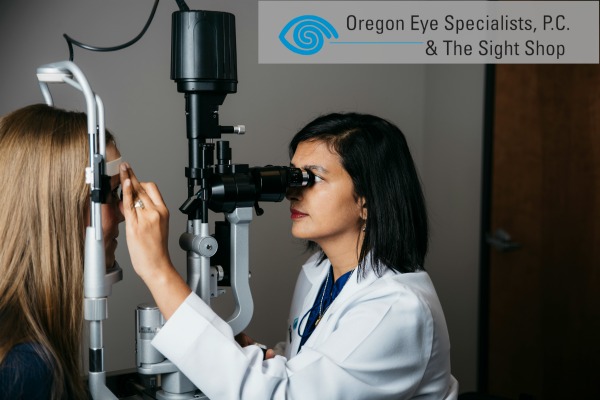Don’t Turn a Blind Eye to Diabetes
The disease’s impact on the eyes comes into focus during National Diabetes Awareness Month
Guest Blog Contributed by Chamber Member Oregon Eye Specialists
National Diabetes Awareness Month, a countrywide initiative to bring attention to the prevention and impact of the prevalent, dangerous affliction, begins November 1, 2018.
November is truly beautiful to behold. Vibrant fall foliage paints the trees but seeing friends and family during the holidays is an even more welcome sight. Taking in the eager, smiling faces set around a magnificent Thanksgiving dinner creates memories that last a lifetime. Vision is something we all take for granted. As the turkey is carved and thanks are shared, it’s also a good time to think about a disease that affects more than 30 million Americans and unbeknownst to many, can lead to blindness.
Education is crucial to understanding and fighting the illness. Insulin is a hormone that regulates the levels of glucose, an essential energy source, in the bloodstream. Type 2 diabetes often develops gradually, when the body produces too little insulin or is resistant to its effects. Type 1 means the pancreas doesn’t create any insulin at all, usually hitting harder and earlier in life. However, both result in critically high blood sugar, which can have disastrous consequences on vital organs, including the eyes.
Dr. Dinelli Monson, M.D. is an ophthalmologist at Oregon Eye Specialists with over 10 years of practicing experience treating patients with diabetes and other ocular diseases. “The retina is an amazing, transparent structure that processes light and allows us to see,” she says. “Just like any other tissue in the body, it’s nourished by blood vessels. So, if we have high levels of sugar in the body, it can cause damage to the blood vessels in the retina, and then the retina stops functioning well.”
This impairment, known as diabetic retinopathy, can manifest in several ways, each limiting a person’s ability to see. One involves the leaking of blood products into the eye, causing swelling known as macular edema. Other times, blood is unable to flow through the vessels, like faulty pipes, leading to ischemia, and ultimately dying tissue. Sometimes, to compensate for insufficiencies, new blood vessels can grow in places they shouldn’t, disrupting the natural anatomy of the eye. Secondary complications are a possibility too. “Cataracts tend to develop at an earlier age in diabetics, and they have nearly double the risk of glaucoma,” explains Monson.
What makes diabetic retinopathy such a threat is that nearly one in four people living with diabetes don’t know that they have the disease, and about 90 percent of pre-diabetics are unaware of their condition. “Early retinopathy is often silent, which is the danger. Later in the disease symptoms could present as blurry vision, dark spots, or difficulty adjusting when you look at things from far away to near,” Monson says. “Colors can be faded. Sometimes, if there’s a bleed inside, people can notice increased floaters in their eyes.”
Early detection, timely treatment, and appropriate follow-ups are the most effective tools in keeping diabetic retinopathy in check. It all starts with scheduling regular eye exams. Doctors will test vision, the pressure inside the eye and dilate the pupils with drops. “That’s when we shine our lights and use our lenses to magnify the inner lining of the eye so that we can take a good look,” Monson says. Taking photos can also help specialists track the progression or decline of health over time. “One thing that is very important to emphasize to our patients is to actually get the rest of their body’s glucose under control.”
For mid to late-stage patients, there are medications that can be injected into the eyes, and surgical measures can be utilized for advanced symptoms. Laser photocoagulation is a minimally invasive procedure that seals leaking blood vessels or retinal tears and can destroy abnormal tissues. To repair extensive internal damage, a vitrectomy, where some of the vitreous humor is removed from the eye, is also an option.
“I want to emphasize that there’s always an opportunity to improve our health, for all of us,” says Monson. “That being said, although it sounds very scary to many people to not have good vision, there are so many people who have no sight that have very happy, productive lives.” From low vision specialists, rehabilitation services to guide dogs, there are many resources available. The Oregon Commission for the Blind offers low vision devices, free consultations and can also assist with transitioning at school or work. The State Library of Oregon has a selection of Braille and large print books and the American Academy of Ophthalmology will advocate for patients.
Though there still is no cure for diabetes, medical innovations have made living with the disease possible. For those who are recently diagnosed, especially with type 2, Dr. Monson suggests getting your eyes checked immediately – it’s possible you’ve had it for a while and not known – and annually from then on. It’s a simple step to take to help ensure you’ll be able to appreciate those friendly faces for years to come.
 For more information on this topic, contact Oregon Eye Specialist | www.oregoneyes.net
For more information on this topic, contact Oregon Eye Specialist | www.oregoneyes.net
ทดลองเล่น PG SLOTสล็อตเว็บตรงufa191สล็อตjoker123ufabet911สล็อตเว็บสล็อต pg ราคาบอลสล็อตเว็บตรงยักษ์888

